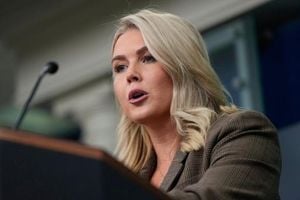On August 19, 2025, a wave of activism swept across George Washington University (GW), as more than 45 student organizations banded together to demand that the university declare itself a “sanctuary campus.” Their petition, which calls for the banning of all law enforcement—including Immigration and Customs Enforcement (ICE) and the D.C. Metropolitan Police Department—from campus, is not just about local policing. It’s a direct response to sweeping changes in federal policy under President Trump’s second term, and a protest against a Department of Justice finding that GW was “deliberately indifferent” to campus anti-Semitism.
This movement at GW is emblematic of a much broader struggle unfolding across American higher education. According to the Washington Free Beacon, the petition also urges GW to refuse cooperation with “government efforts to surveil, monitor, deport, or otherwise punish or harm students, workers, faculty, and staff,” and to provide legal support for any students facing deportation or prosecution. The GW Socialist Action Initiative, a student group advocating for the “total eradication of the capitalist-imperialist system,” is leading the campaign alongside anti-Israel groups such as Students for Justice in Palestine (SJP), Jewish Voice for Peace, the Student Coalition for Palestine, and the Palestinian Youth Movement.
These demands come at a time of unprecedented federal intervention in higher education. The Trump administration has federalized D.C.’s police department, added ICE officers, and expanded deportations—a move that has sparked both fear and outrage among students and faculty. The Justice Department concluded that GW’s failure to address anti-Semitic incidents created a hostile environment for Jewish, American-Israeli, and Israeli students and faculty. The university now faces enforcement action unless it agrees to a voluntary resolution.
But for the GW Socialist Action Initiative and its allies, any deal with the Trump administration is fraught with danger. “Any deal that GW could reach with the Trump Administration will harm student life and wellbeing,” the group declared in a recent Instagram post, as reported by the Washington Free Beacon. “With the Trump Administration’s recent letter to GW no sector of our community is safe. From activism, to DEI, to healthcare, no policy or student protection is safe in the wake of this administration’s attack on education.” The message is clear: students see themselves as the last line of defense against what they perceive as a coordinated assault on campus freedoms.
For GW’s Jewish community, the sense of insecurity is palpable. Since Hamas’s October 7, 2024, terror attack, anti-Semitic harassment on campus has surged. The Department of Justice’s letter cited multiple incidents, including Jewish students being surrounded and subjected to antisemitic slurs, forcing them to flee. In May 2025, a group of Jewish students sued GW, alleging the university failed to address “pervasive and severe anti-semitic harassment.” The lawsuit details disturbing episodes, such as the GW SJP president allegedly spitting on a Jewish plaintiff and another SJP member loudly insulting Jewish students as they tried to leave an anti-Israel encampment in spring 2024.
GW’s SJP chapter first called for sanctuary campus status in May 2025, during a march to university president Ellen Granberg’s residence. “As students and faculty nationwide continue facing fascist repression and threats of deportation, it is critical that GW concede to our demands and truly stand by its community,” they posted on Instagram. Their demands echo similar efforts at Columbia University, where the graduate student union in March 2025 called for the university to ban public safety officers from “organizing spaces, including classrooms,” destroy all records related to protest participants, and even sue the Trump administration.
GW’s administration, meanwhile, is trying to walk a tightrope. In a statement provided to the Washington Free Beacon, a university spokeswoman said, “The university also has robust policies in place protecting lawful expression and maintaining an environment free from discrimination and harassment. At the same time, we continue to follow and comply with local and federal law, including those relating to immigration.” The statement emphasized GW’s commitment to supporting immigrant and international communities and fostering a safe educational environment, but also its obligation to comply with the law.
Stepping back, the turmoil at GW is just one front in a nationwide battle over the soul and purpose of American higher education. As reported by OpenDemocracy, the Trump administration’s second term has brought a “torrent of policy changes” to universities across the country. Executive orders have targeted cultural institutions, aiming to “restore truth” and root out “wokeism.” The Kennedy Centre for the Performing Arts has been renamed after Donald Trump, and the Smithsonian museums have been ordered to purge narratives about slavery and diversity.
Harvard University, often seen as the crown jewel of American academia, faces millions in federal funding cuts and the loss of eligibility to host international students. In July 2025, Harvard suppressed an entire issue of the Harvard Educational Review that focused on Palestinian studies, in what a university official called “anticipatory compliance.” Scholars have been demoted, partnerships with West Bank institutions suspended, and all programs focused on Palestine canceled. The chilling effect has rippled through the entire higher education sector.
The Trump administration’s approach is modeled in part on Viktor Orbán’s “illiberal democracy” in Hungary. According to OpenDemocracy, far-right think tanks such as the Heritage Foundation and the Claremont Institute have provided intellectual ammunition for this campaign. In Hungary, Orbán forced the closure of gender and women’s studies, drove the Central European University out of the country, and restructured university governance to eliminate dissent and diversity. The Academic Freedom Index has documented a “dramatic” decline in academic freedom in Hungary—a warning sign for American institutions.
In the U.S., the administration’s rhetoric is laced with conspiracy theories about “Cultural Marxism,” a term used to attack diversity, equity, and inclusion efforts. Trump’s 2024 election manifesto promised to “remove all Marxist diversity, equity and inclusion bureaucrats” and root out “the Marxist maniacs infecting educational institutions.” The analogy to Hitler’s use of “Cultural Bolshevism” to align German universities with Nazi ideology is not lost on critics.
Backing this ideological offensive is a cadre of tech billionaires, such as Peter Thiel and Marc Andreessen, who support authoritarian libertarianism and envision a future where decision-making is driven by algorithms rather than democracy. Ironically, as OpenDemocracy points out, these “tech-fascists” owe their fortunes to science produced in universities, yet support policies that would undermine the very institutions that made their success possible. New AI companies like Palantir and Andoril, supported by the Trump administration, are developing technologies to track immigrants in real time and sharing surveillance tools with Israel for use in Gaza.
Despite the grim outlook, resistance is mounting. Faculty unionization is surging, and organizations like the American Association of University Professors (AAUP) are leveraging the law to expose the administration’s covert immigration policing and to defend academic freedom. The first major trial of Trump’s second term, AAUP v. Rubio, challenges the administration’s deportation policy in court. The AAUP is also pressuring university presidents to protect scholars at risk, drawing lessons from the Red Scare of the 1950s when academics were purged for alleged Communist ties.
On the ground, the collective power of student encampments—especially those protesting the war in Gaza—has rattled the establishment. The backlash began under the Biden administration but has intensified under Trump, leaving students and faculty searching for ways to push back against what they see as an existential threat to academic freedom and university autonomy.
As the struggle continues, the future of American higher education hangs in the balance, caught between competing visions of what universities should be: sanctuaries of free thought and diversity, or instruments of a new ideological order. The choices made now will reverberate for generations.





